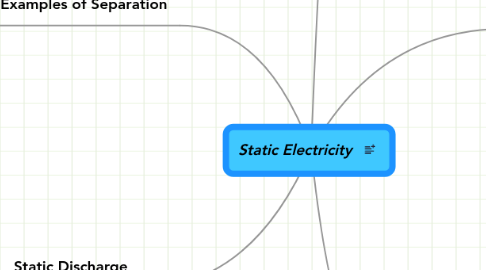
1. Examples of Separation
1.1. Pressure-induced charge separation
1.1.1. Applied mechanical stress generates a separation of charge in certain types of crystals and ceramics molecules.
1.2. Heat-induced charge separation
1.2.1. Heating generates a separation of charge in the atoms or molecules of certain materials. All pyroelectric materials are also piezoelectric. The atomic or molecular properties of heat and pressure response are closely related.
1.3. Charge-induced charge separation
1.3.1. Electrons can be exchanged between materials on contact; materials with weakly bound electrons tend to lose them, while materials with sparsely filled outer shells tend to gain them.
1.3.1.1. Examples
1.3.1.1.1. a balloon rubbed against the hair becomes negatively charged; when near a wall, the charged balloon is attracted to positively charged particles in the wall, and can "cling" to it, appearing to be suspended against gravity
2. Static Discharge
2.1. The spark associated with static electricity is caused by electrostatic discharge, or simply static discharge, as excess charge is neutralized by a flow of charges from or to the surroundings.
2.1.1. Examples of Static Discharge
2.1.1.1. Lightning
2.1.1.1.1. How?
3. Causes of Static Electricity
3.1. he phenomenon of static electricity requires a separation of positive and negative charges.
3.2. Normally, materials are made of atoms and molecules that are electrically neutral, having an equal number of positive charges and negative charges.
3.3. When two materials are in contact, electrons may move from one material to the other, which leaves an excess of positive charge on one material, and an equal negative charge on the other. When the materials are separated they retain this charge imbalance.
4. What is the meaning of it
4.1. the build up of electric charge on the surface of objects.
4.2. Static electricity can be contrasted with current (or dynamic) electricity, which can be delivered through wires as a power source.
4.2.1. INS to insert (Windows)
4.2.2. TAB to insert (Mac OS)
4.2.3. ENTER to add siblings
4.2.4. DEL to delete
4.2.5. All key shortcuts
4.3. Although charge exchange can happen whenever any two surfaces come into contact and separate, a static charge only remains when at least one of the surfaces has a high resistance to electrical flow (an electrical insulator).
4.4. What is the effect?
4.4.1. Online Help
4.4.2. The effects of static electricity are familiar to most people because we can feel, hear, and even see the spark as the excess charge is neutralized when brought close to a large electrical conductor (for example, a path to ground)
4.4.2.1. Personal Todo List
4.4.2.2. Vacation Planning
4.4.2.3. Meeting Minutes
4.4.2.4. Project Plan
4.4.2.5. more...
4.4.3. a region with an excess charge of the opposite polarity (positive or negative). The familiar phenomenon of a static 'shock' is caused by the neutralization of charge.
4.4.3.1. Offline Mode
4.4.3.2. Geistesblitz Tools
4.4.3.3. Email & SMS Gateways
4.4.3.4. Compare Editions
